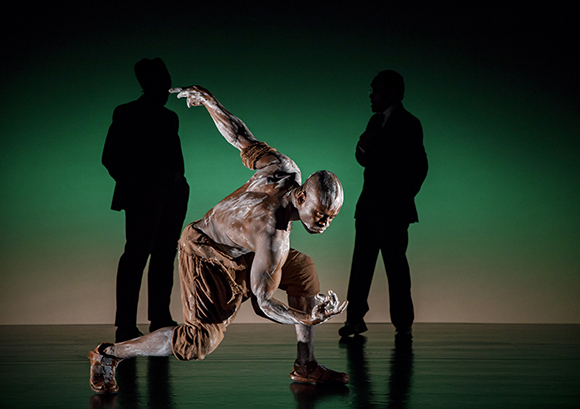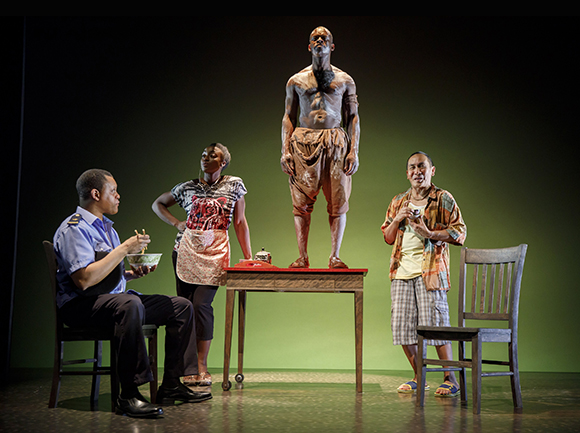
Sahr Ngaujah is extraordinary as an endangered elephant in Mlima’s Tale (photo by Joan Marcus)
Martinson Hall, the Public Theater
425 Lafayette St. at Astor Pl.
Tuesday through Sunday through June 3, $85-$150
212-539-8500
www.publictheater.org
In 2015, a Minnesota dentist became an international pariah when he shot and killed a beloved thirteen-year-old lion named Cecil in Zimbabwe’s Hwange National Park, purely for sport and a photo op. In the 2017 documentary Trophy, Shaul Schwarz and Christina Clusiau went deep inside the big business of trophy hunting, focusing on the industry surrounding the hunting of the Big Five: buffalo, leopards, elephants, lions, and rhinos. In Mlima’s Tale, which was just extended through June 3 at the Public’s Martinson Hall, two-time Pulitzer Prize winner Lynn Nottage follows the money after a treasured elephant is killed for his magnificent tusks in a national park in Kenya. Nottage, who traveled to Democratic Republic of Congo for Ruined to tell the harrowing story of rape and sexual abuse there, and went to Reading, Pennsylvania, to look at a factory town in trouble in Sweat (which began in Martinson Hall before transferring to Broadway), now takes theatergoers to the African savannah, where the mighty Mlima is facing death. The mammal is sensationally portrayed by the tall, powerfully built Sahr Ngaujah, who displays an impressive, chiseled chest and a deep, dark stare, his movements a kind of contemporary dance.
As the play opens, Mlima is on a spare stage, a full moon projected behind him. His speech is accompanied by elephant sounds in the background. “You must listen with your entire body, feel how the earth shifts when there’s the slightest disruption, because how you listen can mean the difference between life and death. It’s the truth of the savannah, something we all learn at a very young age,” he says, remembering what his grandmother taught him, echoing words spoken by many African and black American parents and grandparents to their children and grandchildren. Two hunters, the impatient Rahman (Ito Aghayere) and the older, wiser Geedi (Jojo Gonzalez), approach the fatally wounded Mlima, waiting for him to die so they can cut off his tusks. Geedi believes the proud animal should be treated with the respect he deserves, while Rahman recalls a Maasai legend, saying, “If you not give elephant proper burial, he’ll haunt you forever.” Just before dying, Mlima calls out to his brother, “Let reason rule your anger, and don’t come to mourn me! Run! Run!” Geedi then removes the unseen tusks and brings them to police chief Githinji (Kevin Mambo), setting in motion a La Ronde-like narrative structure in which one character from each scene continues into the next (with two exceptions) as the tusks, now represented by Ngaujah with white streaks across his face and body, are illegally transported by a series of corrupt men, each one taking his cut. Along the way, the spirit of Mlima is alive in the tusks, leaving a white mark of complicity and shame on everyone involved.

Sahr Ngaujah stands tall as Mlima as Kevin Mambo, Ito Aghayere, and Jojo Gonzalez portray characters debating the fate of the elephant’s tusks (photo by Joan Marcus)
Nottage (By the Way, Meet Vera Stark; Intimate Apparel) was inspired to write Mlima’s Tale after a conversation she had with Oscar-winning director Kathryn Bigelow, an animal-rights activist who directed and produced the three-minute 2014 documentary Last Days, about the human and financial cost of the illegal ivory trade and its ties to terrorism. Aghayere (Familiar, Three Days to See), Gonzalez (F**king A, Small Mouth Sounds), and Mambo (The Color Purple, Fela!) play multiple roles, from warden and ship captain to ivory dealer and artist, often changing costumes (by Jennifer Moeller) in less than a minute. Director Jo Bonney (Father Comes Home from the Wars; By the Way, Meet Vera Stark) uses inventive staging for the quick transitions, as a large rectangular board moves horizontally across the front of the stage like a cinematic wipe as such basic props as chairs and tables are changed on Riccardo Hernandez’s set. Each new scene begins with a projected quote, including “Even the night has ears,” “No matter how full the river, it still wants to grow,” and “A single stick might smoke, but it will not burn.” Composer and music director Justin Hicks stands on the floor, next to the stage, effectively mixing music and natural sounds to maintain the stark atmosphere. (The sound design is by Darron L West.)
Tony and Olivier nominee Ngaujah (The Painted Rocks at Revolver Creek, Fela!) is spectacular as Mlima, his accusing eyes penetrating through the other characters as well as the audience, implicating all of us, his breathtaking movement seeking to regain power that might never return. (The choreography is by Chris Walker.) When he stands high on a table and is examined by prospective tusk buyers, it is like he is an African slave being sold at auction. But Nottage and Bonney don’t overplay that connection, instead focusing attention on the plight of the elephants, whose population has dropped from 1.3 million to 400,000 over the last several decades. “There are more elephants being killed than are being born, which means that in less than twenty years they may well be extinct,” a white Kenyan says in the play. Coincidentally, around the corner from the Public Theater, in Astor Plaza, is Gillie & Marc’s “The Last Three,” a bronze sculpture depicting three northern white rhinos, one atop the other, symbolizing the potential extinction of the species because of the rhino horn trade; sadly, right after the work was installed, one of the three remaining rhinos died. Mlima’s Tale is a gorgeously rendered, heartbreaking reminder of humanity’s place in the world, how greed and consumption trample over the natural environment and how every choice we make, as individuals and as a society, has an impact on the future of the planet, which is far too heavy with white markings everywhere.